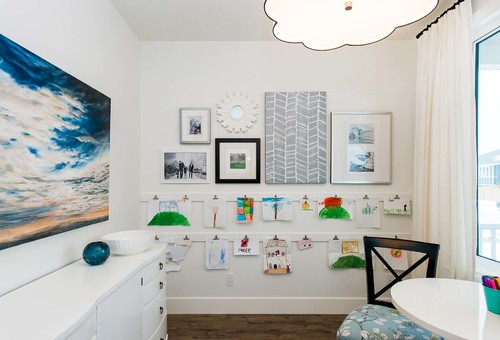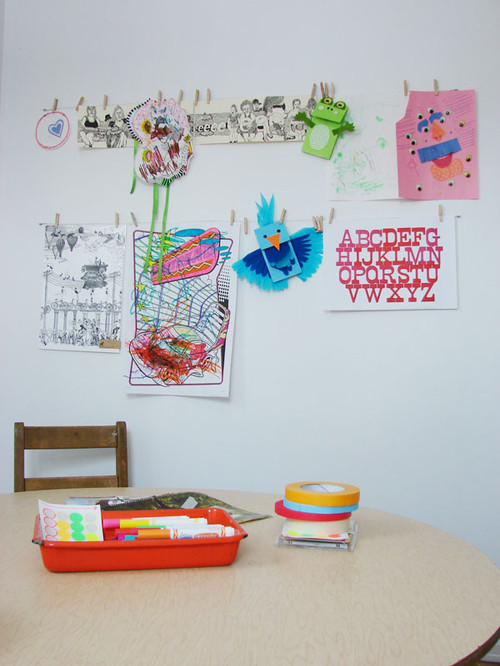Here's What to Do with That Pile of Your Child's Artwork
By the time your child has mastered the crayon, you've probably amassed quite a collection of artwork — every line, scribble, and doodle has been kept. Whether it's on a sheet of paper, the back of a receipt, or on a crumpled napkin, you've made sure to hold on to each masterpiece. And why not? It's important to be proud and celebrate your child's work. Encouraging creativity is a must!
But when your not-so-little one starts preschool, it's a whole new story. At the end of every week, classrooms tend to unload a truckload of projects. If you aren't careful, your home could be swamped in construction paper, glitter, and pipe cleaners! If you've got space for all the projects (say, a lofty suburban garage or a dedicated art room), then have at it!
But it you've got a limited amount of space or are quite the minimalist, the trick is to learn how to curate those pieces of art and find clever ways to display and store them. Here's what you should do:
Display Everything
… and do it right away! Before you even weed through all the artwork and projects, give them all a chance to adorn your home. This shows your children that you truly appreciate and love every piece of art they've created, not just the cookie-cutter projects or the ones that suit your taste.
Hang up clotheslines across a wall or install huge bulletin boards and pin up the artwork. Use colorful painter's or Washi tape to stick them up without damaging the art or the walls. Hang them up on the fridge with magnets. Make sure to throw a fancy gallery opening party.
The point is to (temporarily) display all the art until the next shipment comes in. That way, when you do start to curate and pick out the pieces you want to keep, you don't feel bad about ditching the rest.
Decide What to Keep
As a rule, we like to keep the first and the best of each category. If they had a phase of drawing only fairies, keep the first attempt and the mastered one. You'll be amazed at how quickly they developed their style when you compare the two. Same with mazes they've completed— keep an easy-peasy straight-across maze done at age two, and another that's incredibly complex.
As for school projects, we like to keep those that really show their personality. Everything with their photo, keep. Those that feature little comments/essays/interviews/current favorites, keep! If it's very intricate and you know they spent a lot of time on it, definitely keep it.
Hundreds of those 5-second scribbles, toss. Parent-and-me projects that were really all parent, toss. Super generic and impersonal school artworks ("glue these triangles on the print out basket"), toss.
Make the Most of Digital Archiving
Invest in a good scanner. Get a flatbed one over a sheet-fed one, because most kiddie artwork tends to have glued-on pieces that can be damaged. For larger or three-dimensional pieces, have your child hold the artwork and take a photo of them.
Properly date the folders, and store them in a large-capacity memory stick or an external hard drive, or use one of these apps. By storing the work digitally, you can ensure that you'll always have the memories even when the actual pieces get worn and torn, sun faded, eaten by moths, damaged in a flood, and other awful things.
An elegant way to display the artwork you've digitally uploaded is to create yearly photo books. We absolutely love Blurb.com for its simplicity, high-quality, and excellent pricing. You'll have lovely, hardbound physical copies on your coffee table that won't clash with your décor, and you can ensure that the originals won't get ruined.
Store Your Favorites
Make sure to properly date everything. Have your little one discuss each piece and write a short description on the back. Put everything in a large portfolio with plastic inserts, or if they're too large, stack them up with tissue in between. Place everything in heavy-duty, air-tight, waterproof bins.
For the absolutely magnificent pieces of art, house them in equally stunning frames, and find prominent places for them in your home. Children's art make the home much more lively and colorful, and it adds a touch of whimsy.
It may be overwhelming tackling all this work now, but it's absolutely worth it. Years down the line, when your kiddo technically isn't a "kid" anymore and no longer leaves trails of artworks all over the place, you can both sit down, bust out the Rubbermaid bins, and reminisce about the innocent days of googly eyes and sequins.
Got any clever tips and tricks for storing and displaying artwork? Share them with us in the comments below.












No Comments.